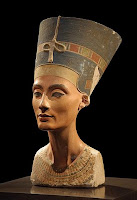The Top 10 Secrets of The Temple of Dendur at NYC’s Met Museum
Reconstruction of Temple of Dendur’s possible paint. Image via Met Museum.
The Metropolitan Museum of Art, with its many secrets, houses a wonderful collection of works that date back to ancient times through the Renaissance. Most notably though, the museum is home to a bona fide Egyptian temple!
The Temple of Dendur, as it’s called, is completely open to the public, which means visitors can walk through its doors and hallways, experiencing the temple as it was originally used. Here are 10 of our favorite fun facts about the structure.
Opera Aida Is Coming To The Pyramids But It’ll Literally Cost You A Fortune
Opera Aida is set to be performed in Egypt alongside at Pyramids of Giza stage on the 8th, 9th, and 10th of March. The show is welcoming an audience of 1500 people; this will be the second time it’s played outside the Opera House, the first being played at the Karnak Temple in Luxor in 1987. The audience should expect an entirely different setting and design than any other!
THE MISADVENTURES OF WENAMUN
"This comic is easily the best retelling of an ancient Egyptian story I've ever seen."
--T.G. Wilfong, Professor of Egyptology, Kelsey Museum of Archaeology, University of Michigan
Drawing on one of the earliest literary travel accounts known to man, travel writer Rolf Potts and illustrator Cedar Van Tassel recreate the comic tale of Wenamun, an ancient Egyptian priest whose overseas voyage in search of Lebanese timber resulted in an ongoing series of fiascos.
Unearthing Hatshepsut, Egypt's Most Powerful Female Pharaoh
Lepsius 1843–45. The Metropolitan Museum of Art, New York, Rogers Fund, 1929
Before the British scholar Terence Gray adopted the name Wei Wu Wei and began his studies in Taoism, he was a budding Egyptologist with an iconoclastic streak. In 1920, seemingly tired of history as it had hitherto been written, he published a biographic study of the Egyptian queen and pharaoh Hatshepsut written not as a dry academic tract, but as a drama.
Nefertiti was no pharaoh, says renowned Egyptologist
The bust of Nefertiti from the Ägyptisches Museum Berlin collection, presently in the Neues Museum.
Contrary to popular opinion, one of the most famous women in ancient history did not rule Egypt, according to a new book.
Dr. Joyce Tyldesley, an Egyptologist from The University of Manchester, says Queen Nefertiti was just one of a series of powerful queens who played an influential role in Egyptian history.
It was, argues Dr. Tyldesley, the beauty of her famous limestone and plaster sculpture—reportedly Hitler's favourite piece of ancient art—which propelled her into the public spotlight after it was put on public display in 1923.
Top Facts about King Ay
Ay receiving the Gold of Honor – Photo Courtesy of Wikipedia
Several secrets around Ancient Egypt and its rulers have not yet been revealed; the magical Egyptian deserts still carry a lot underneath their sands.
Ministry of Antiquities announced that famous Egyptologist, author and former Minister of Antiquties Zahi Hawas will lead an archaeological mission to begin new excavation works at Valley of the Monkeys, located at Valley of the Kings, according to a statement released on the Ministry of Antiquities official Facebook page.
How climate change and population growth threaten Egypt’s ancient treasures
Roger Anis for UN Environment
In his 40-something years as an archaeological excavator on Luxor’s West Bank, Mustafa Al-Nubi has witnessed a flurry of changes.
Tourist numbers have surged, fallen, and then slowly grown again. Local villages have exploded in size. Even the landscape has undergone a radical transformation, as Egyptologists slowly pick their way through the vast Theban Necropolis. “It’s like one big museum now,” Nubi says. “My grandfather would not recognize his own house.”
Researchers use non-visible imaging approach to reveal climate change and population growth threaten Egypt’s ancient treasures
An international team lead by University College London (UCL) researchers has developed a non-destructive multimodal imaging technique that utilizes multispectral imaging and a range of other imaging methods to reveal text from ancient Egyptian mummy cases for research and analysis.
Hidden Ancient Egyptian Paintings Revealed Thanks To New Digital Imaging Tool
Scientists have used a new imaging technique to re-examine Egyptian art and find details that were previously missing.
Linda Evans and Anna-Latifa Mourad from Macquarie University in Sydney, Australia describe in their paper in the Journal of Archaeological Science how they used a technique called DStretch to analyze the ancient paintings. These paintings were found at Beni Hassan, an ancient Egyptian cemetery that’s located near to the city of Minya in modern Egypt.
The Earliest Music in Ancient Egypt video
This video supplements Heidi Köpp-Junk's article, "The Earliest Music in Ancient Egypt," featured in The Ancient Near East Today. Visit http://asorblog.org/2018/01/16/earlie... to read the article.
Ancient Egyptian Humor Video
Horrible Histories - Egyptian Gods and The Devourer - YouTube from Ellen Warburton on Vimeo.
Pictures of the Week
Moving the statue of Ramses II to the Grand Egyptian Museum.




















































